chevrolet tahoe (2009) Service Manuals

2009 Chevrolet Tahoe, Suburban Owner Manual M
Seats and Restraint System ............................. |
1-1 |
Head Restraints ......................................... |
1-2 |
Front Seats ............................................... |
1-4 |
Rear Seats .............................................. |
1-14 |
Safety Belts ............................................. |
1-32 |
Child Restraints ....................................... |
1-54 |
Airbag System ......................................... |
1-81 |
Restraint System Check ............................ |
1-98 |
Features and Controls ..................................... |
2-1 |
Keys ........................................................ |
2-3 |
Doors and Locks ...................................... |
2-10 |
Windows ................................................. |
2-19 |
Theft-Deterrent Systems ............................ |
2-22 |
Starting and Operating Your Vehicle ........... |
2-26 |
Mirrors .................................................... |
2-52 |
Object Detection Systems .......................... |
2-56 |
OnStar® System ...................................... |
2-68 |
Universal Home Remote System ................ |
2-71 |
Storage Areas ......................................... |
2-78 |
Sunroof .................................................. |
2-81 |
Instrument Panel ............................................. |
3-1 |
Instrument Panel Overview .......................... |
3-4 |
Climate Controls ...................................... |
3-22 |
Warning Lights, Gages, and Indicators ........ |
3-34 |
Driver Information Center (DIC) .................. |
3-51 |
Audio System(s) ....................................... |
3-83 |
Driving Your Vehicle ....................................... |
4-1 |
Your Driving, the Road, and the Vehicle ....... |
4-2 |
Towing ................................................... |
4-43 |
Service and Appearance Care .......................... |
5-1 |
Service ..................................................... |
5-3 |
Fuel ......................................................... |
5-5 |
Checking Things Under the Hood ............... |
5-12 |
Rear Axle ............................................... |
5-49 |
Four-Wheel Drive ..................................... |
5-51 |
Front Axle ............................................... |
5-52 |
Headlamp Aiming ..................................... |
5-53 |
Bulb Replacement .................................... |
5-56 |
Windshield Wiper Blade Replacement ......... |
5-59 |
Tires ...................................................... |
5-61 |

Appearance Care ................................... |
5-106 |
Vehicle Identification ............................... |
5-114 |
Electrical System .................................... |
5-114 |
Capacities and Specifications ................... |
5-122 |
Maintenance Schedule ..................................... |
6-1 |
Maintenance Schedule ................................ |
6-2 |
Customer Assistance Information .................... |
7-1 |
Customer Assistance and Information ........... |
7-2 |
Reporting Safety Defects ........................... |
7-14 |
Vehicle Data Recording and Privacy ........... |
7-16 |
Index ................................................................ |
1 |

GENERAL MOTORS, GM, the GM Emblem, CHEVROLET, the CHEVROLET Emblem, and the names TAHOE, SUBURBAN, and Z71 are registered trademarks of General Motors Corporation.
This manual includes the latest information at the time it was printed. GM reserves the right to make changes
in the product after that time without notice. For vehicles first sold in Canada, substitute the name “General Motors of Canada Limited” for Chevrolet Motor Division wherever it appears in this manual.
This manual describes features that may or may not be on your specific vehicle.
Read this manual from beginning to end to learn about the vehicle’s features and controls. Pictures, symbols, and words work together to explain vehicle operation.
Litho in U.S.A.
Part No. 15911385 B Second Printing
If your vehicle is a Two-mode Hybrid, see the Two-mode Hybrid manual for more information.
Keep this manual in the vehicle for quick reference.
Canadian Owners
Canadian Owners (Propriétaires
Canadiens)
A French language copy of this manual can be obtained from your dealer/retailer or from:
On peut obtenir un exemplaire de ce guide en français auprès du concessionnaire ou à l’adresse suivante:
Helm, Incorporated
P.O. Box 07130
Detroit, MI 48207
1-800-551-4123
Numéro de poste 6438 de langue française www.helminc.com
General Motors Corporation. All Rights Reserved.
iii

Index
To quickly locate information about the vehicle, use the index in the back of the manual. It is an alphabetical
list of what is in the manual and the page number where it can be found.
Safety Warnings and Symbols
A circle with a slash through it is a safety symbol which means “Do Not,” “Do not do this,”
or “Do not let this happen.”
A box with the word CAUTION is used to tell about things that could hurt you or others if you were to ignore the warning.
{ CAUTION:
These mean there is something that could hurt you or other people.
Cautions tell what the hazard is and what to do to avoid or reduce the hazard. Read these cautions.
A notice tells about something that can damage the vehicle.
Notice: These mean there is something that could damage your vehicle.
Many times, this damage would not be covered by the vehicle’s warranty, and it could be costly. The notice tells what to do to help avoid the damage.
There are also warning labels on the vehicle which use the same words, CAUTION or Notice.
Vehicle Symbols
The vehicle has components and labels that use symbols instead of text. Symbols are shown along with the text describing the operation or information relating to a specific component, control, message, gage, or indicator.
M : This symbol is shown when you need to see your owner manual for additional instructions or information.
* : This symbol is shown when you need to see a service manual for additional instructions or information.
iv

Vehicle Symbol Chart
Here are some additional symbols that may be found on the vehicle and what they mean. For more information on the symbol, refer to the index.
0 : Adjustable Pedals
9 : Airbag Readiness Light
# : Air Conditioning
! : Antilock Brake System (ABS)
g : Audio Steering Wheel Controls or OnStar®
$ : Brake System Warning Light
" : Charging System
I : Cruise Control
B : Engine Coolant Temperature
O : Exterior Lamps
# : Fog Lamps
. : Fuel Gage
+ : Fuses
i : Headlamp High/Low-Beam Changer
j : LATCH System Child Restraints
* : Malfunction Indicator Lamp
: : Oil Pressure
g : Outside Power Foldaway Mirrors
} : Power
/ : Remote Vehicle Start
> : Safety Belt Reminders
7 : Tire Pressure Monitor
_ : Tow/Haul Mode
F : Traction Control
M : Windshield Washer Fluid
v
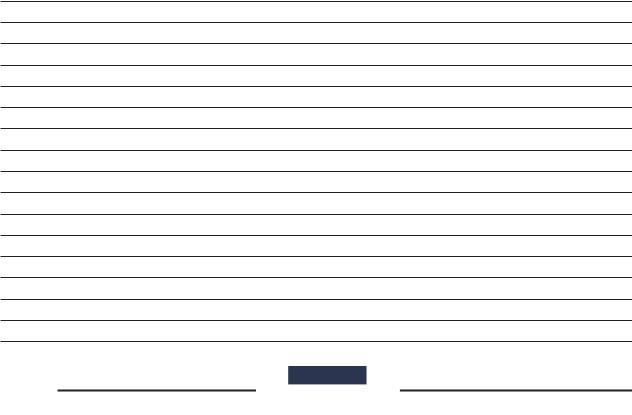
NOTES
vi

Section 1 Seats and Restraint System
Head Restraints ............................................... |
1-2 |
Front Seats ...................................................... |
1-4 |
Manual Seats ................................................ |
1-4 |
Power Seats .................................................. |
1-5 |
Manual Lumbar .............................................. |
1-6 |
Power Lumbar ............................................... |
1-6 |
Heated Seats ................................................. |
1-7 |
Heated and Cooled Seats ................................ |
1-8 |
Memory Seat, Mirrors, and Pedals .................... |
1-8 |
Reclining Seatbacks ...................................... |
1-10 |
Center Seat ................................................. |
1-13 |
Rear Seats ..................................................... |
1-14 |
Heated Seats ............................................... |
1-14 |
60/40 Split Bench Seat (Second Row) ............. |
1-14 |
Bucket Seats (Second Row) ........................... |
1-20 |
Third Row Seat ............................................ |
1-27 |
Safety Belts ................................................... |
1-32 |
Safety Belts: They Are for Everyone ................ |
1-32 |
How to Wear Safety Belts Properly ................. |
1-37 |
Lap-Shoulder Belt ......................................... |
1-45 |
Safety Belt Use During Pregnancy .................. |
1-52 |
Lap Belt ...................................................... |
1-52 |
Safety Belt Extender ..................................... |
1-53 |
Child Restraints ............................................. |
1-54 |
Older Children ............................................. |
|
Infants and Young Children ........................... |
|
Child Restraint Systems ................................. |
1-61 |
Where to Put the Restraint ............................. |
1-63 |
Lower Anchors and Tethers for |
|
Children (LATCH) ...................................... |
1-65 |
Securing a Child Restraint in a |
|
Rear Seat Position .................................... |
1-73 |
Securing a Child Restraint in the |
|
Center Front Seat Position .......................... |
1-77 |
Securing a Child Restraint in the |
|
Right Front Seat Position ............................ |
1-77 |
Airbag System ............................................... |
1-81 |
Where Are the Airbags? ................................ |
1-83 |
When Should an Airbag Inflate? ..................... |
1-86 |
What Makes an Airbag Inflate? ....................... |
1-87 |
How Does an Airbag Restrain? ....................... |
1-88 |
What Will You See After an Airbag Inflates? ..... |
1-88 |
Passenger Sensing System ............................ |
1-90 |
Servicing Your Airbag-Equipped Vehicle ........... |
1-96 |
Adding Equipment to Your Airbag-Equipped |
|
Vehicle .................................................... |
1-96 |
Restraint System Check .................................. |
1-98 |
Checking the Restraint Systems ...................... |
1-98 |
Replacing Restraint System Parts After |
|
a Crash ................................................... |
1-99 |
|
1-1 |
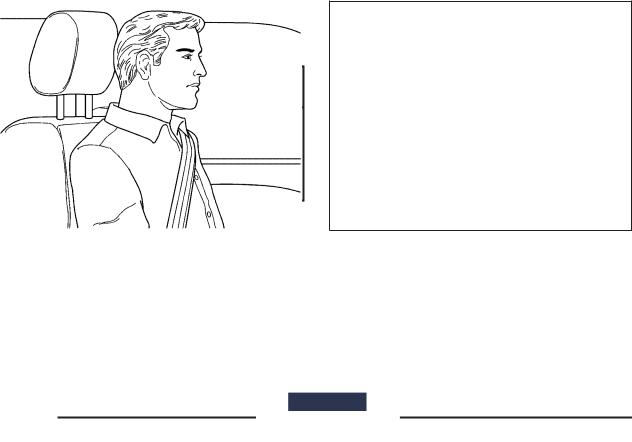
Head Restraints
The front seats have adjustable head restraints in the outboard seating positions.
{ CAUTION:
With head restraints that are not installed and adjusted properly, there is a greater chance that occupants will suffer a neck/spinal injury in a crash. Do not drive until the head restraints for all occupants are installed and adjusted properly.
Adjust the head restraint so that the top of the restraint is at the same height as the top of the occupant’s head. This position reduces the chance of a neck injury in a crash.
1-2

Push down on the head restraint after the button is released to make sure that it is locked in place.
The head restraints are not designed to be removed.
The rear seat has head rests that can be adjusted up and down.
Pull the head restraint up to raise it. To lower the head restraint, press the button, located on the top of the seatback, and push the restraint down.
1-3

Front Seats
Manual Seats
{ CAUTION:
You can lose control of the vehicle if you try to adjust a manual driver’s seat while the vehicle is moving. The sudden movement could startle and confuse you, or make you push a pedal when you do not want to. Adjust the driver’s seat only when the vehicle is not moving.
If the vehicle has a manual seat, it can be moved forward or rearward.
1. Lift the bar to unlock the seat.
2. Slide the seat to the desired position and release the bar.
Try to move the seat with your body to be sure the seat is locked in place.
1-4
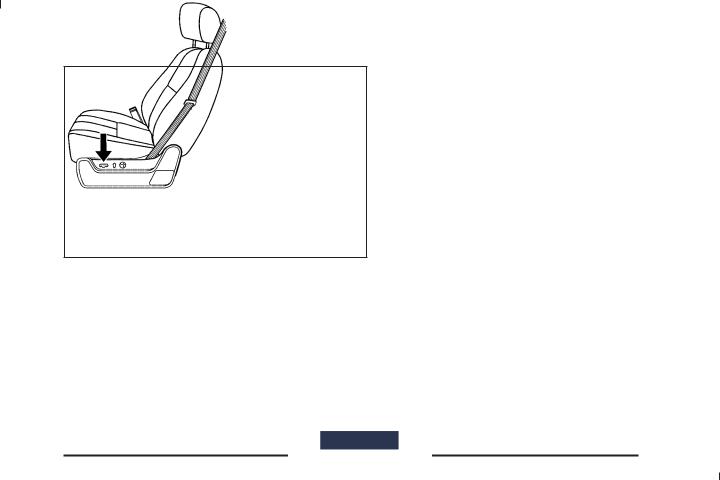
Power Seats
Driver’s Seat with Power Seat Control, Power Recline, and Power Lumbar shown
On a vehicle with power seats, the controls used to operate them are located on the outboard side of the seats.
Move the seat forward or rearward by sliding the control forward or rearward.
Your vehicle may have additional features to adjust your vehicle’s power seat:
•Raise or lower the front part of the seat cushion by moving the front of the control up or down.
•Raise or lower the rear part of the seat cushion by moving the rear of the control up or down.
•Raise or lower the entire seat by moving the entire control up or down.
On seats with power reclining seatbacks, the control is located behind the power seat control on the outboard side of the seats. See “Power Reclining Seatbacks” under Reclining Seatbacks on page 1-10.
A vehicle with a memory function allows seat settings to be saved and recalled. See Memory Seat, Mirrors,
and Pedals on page 1-8 for more information.
1-5

Manual Lumbar |
Power Lumbar |
|
|
|
|
On vehicles with this feature the control is located on the outboard side of the seat.
Increase or decrease lumbar support by turning the knob forward or rearward.
On seats with power lumbar, the controls used to operate this feature are located on the outboard side of the seats.
•To increase lumbar support, press and hold the front of the control.
•To decrease lumbar support, press and hold the rear of the control.
1-6
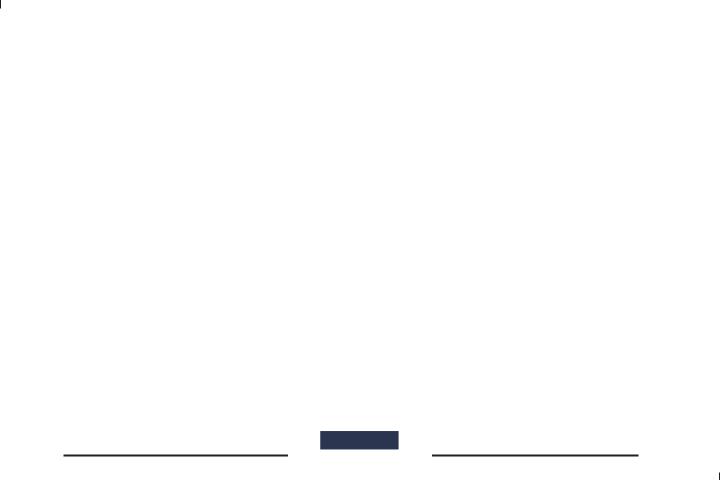
The vehicle may have additional features to adjust your vehicle’s power seat:
•To raise the height of the lumbar support, press and hold the top of the control.
•To lower the height of the lumbar support, press and hold the bottom of the control.
Release the control when the lower seatback reaches the desired level of lumbar support.
Your vehicle may have a memory function which allows seat settings to be saved and recalled. See Memory Seat, Mirrors, and Pedals on page 1-8 for more information.
Keep in mind that as your seating position changes, as it may during long trips, so should the position of
your lumbar support. Adjust the seat as needed.
Heated Seats
On vehicles with heated front seats, the controls are located on the driver and passenger doors.
I (Heated Seatback): Press to turn on the heated seatback.
J (Heated Seat and Seatback): Press to turn on the heated seat and seatback.
The light on the button will come on to indicate that the feature is working. Press the button to cycle through the temperature settings of high, medium, and low and to turn the heat to the seat off. Indicator lights will show the level of heat selected: three for high, two for medium, and one for low.
The heated seats will be canceled 10 seconds after the ignition is turned off. To use the heated seat feature after restarting the vehicle, press the heated seat
or seatback button again.
1-7

Heated and Cooled Seats
If the front seats have the heated and cooled seat feature, the buttons used to control this feature
are located on the front doors near the door handle.
{ (Cooled Seat): To cool the entire seat, press the button with the cooled seat symbol.
This symbol will appear on the climate control display to indicate that the feature is on. Press the button to
cycle through the temperature settings of high, medium, and low and to turn the cooled seat off. Indicator
bars next to the symbol designate the level of cooling selected: three for high, two for medium, and one
for low.
+ (Heated Seatback): To heat only the seatback, press the button with the heated seatback symbol.
This symbol will appear on the climate control display to indicate that the feature is on. Press the button to cycle through the temperature settings of high, medium, and low and to turn the heated seatback off. Indicator bars next to the symbol designate the level of heat selected: three for high, two for medium, and one for low.
z (Heated Seat and Seatback): To heat the entire seat, press the button with the heated seat and seatback symbol.
This symbol will appear on the climate control display to indicate that the feature is on. Press the button to cycle through the temperature settings of high, medium, and low and to turn the heated seat off. Indicator bars next to the symbol designate the level of heat selected: three for high, two for medium, and one for low.
The heated and cooled seats will be canceled after the ignition is turned off. To use the heated and cooled seat feature after the vehicle is started, you will need to press the appropriate seat button again.
Memory Seat, Mirrors, and Pedals
Your vehicle may have the memory package.
The controls for this feature are located on the driver’s door panel, and are used to program
and recall memory settings for the driver’s seat, outside mirrors, and the adjustable throttle and brake pedal.
1-8

To save seating positions in memory:
1.Adjust the driver’s seat, including the seatback recliner and lumbar, both outside mirrors, and the throttle and brake pedals to a comfortable position.
See Outside Power Mirrors on page 2-53 and Adjustable Throttle and Brake Pedal on page 2-30 for more information.
Not all mirrors, adjustable throttles and brake pedals, or power lumbar will have the ability to save and recall their positions.
2.Press and hold button 1 until two beeps sound to indicate that the position has been stored.
A second seating, lumbar, mirror, and throttle and brake pedal position can be programmed by repeating the above steps and pressing button 2.
To recall the memory positions, the vehicle must be in PARK (P). Press and release either button 1 or button 2 corresponding to the desired driving position. The
seat, outside mirrors, and adjustable throttle and brake pedals will move to the position previously stored. You will hear a single beep.
If you use the remote keyless entry transmitter to enter your vehicle and the remote recall memory feature
is on, automatic seat, adjustable mirror, and adjustable pedal movements will occur. See “MEMORY SEAT RECALL” under DIC Vehicle Customization (With DIC Buttons) on page 3-74 for more information.
To stop recall movement of the memory function at any time, press one of the power seat controls, memory buttons, power mirror buttons, or adjustable pedal switch.
If something has blocked the driver’s seat and/or the adjustable pedals while recalling a memory position, the driver’s seat and/or the adjustable pedals recall may stop working. If this happens, remove the obstruction and press the appropriate control for the area that is not responding for two seconds. Try recalling the memory position again by pressing the appropriate memory button. If the memory position is still not recalling, see your dealer for service.
1-9
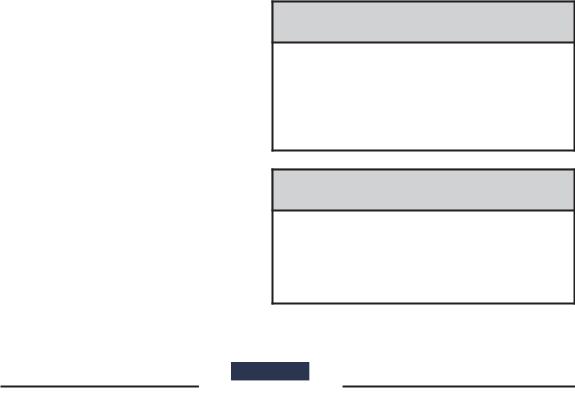
Easy Exit Seat
The control for this feature is located on the driver’s door panel between buttons 1 and 2.
With the vehicle in PARK (P), the driver’s seat exit position can be recalled by pressing the exit button. You will hear a single beep, and the driver’s seat will
move back.
If the easy exit seat feature is programmed in the Driver Information Center (DIC), automatic seat movement
will occur when the key is removed from the ignition. See “EASY EXIT SEAT” under DIC Vehicle Customization (With DIC Buttons) on page 3-74 for more information.
The memory seat and easy exit features can also be programmed using the DIC.
For programming information, see DIC Vehicle Customization (With DIC Buttons) on page 3-74.
Reclining Seatbacks
{ CAUTION:
You can lose control of the vehicle if you try to adjust a manual driver’s seat while the vehicle is moving. The sudden movement could startle and confuse you, or make you push a pedal when you do not want to. Adjust the driver’s seat only when the vehicle is not moving.
{ CAUTION:
If either seatback is not locked, it could move forward in a sudden stop or crash. That could cause injury to the person sitting there. Always push and pull on the seatbacks to be sure they are locked.
1-10

{ CAUTION:
Sitting in a reclined position when your vehicle is in motion can be dangerous. Even if you buckle up, your safety belts cannot do their job when you are reclined like this.
The shoulder belt cannot do its job. In a crash, you could go into it, receiving neck or other injuries.
The lap belt cannot do its job either. In a crash the belt could go up over your abdomen. The belt forces would be there, not at your pelvic bones. This could cause serious internal injuries.
For proper protection when the vehicle is in motion, have the seatback upright. Then sit well back in the seat and wear your safety belt properly.
1-11

Manual Reclining Seatbacks
On seats with manual reclining seatbacks, the lever used to operate them is located on the outboard side of the seat(s).
To recline the seatback:
1.Lift the recline lever.
2.Move the seatback to the desired position, then release the lever to lock the seatback in place.
3.Push and pull on the seatback to make sure it is locked.
To return the seatback to an upright position, do the following:
1.Lift the lever fully without applying pressure to the seatback and the seatback will return to the upright position.
2.Push and pull on the seatback to make sure it is locked.
1-12
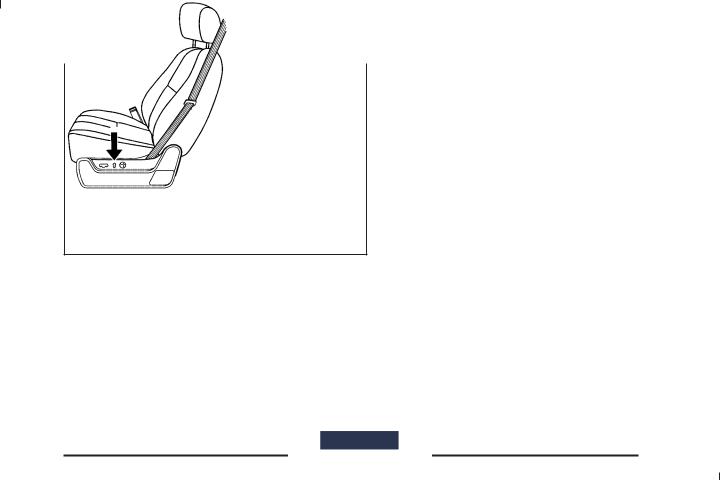
Power Reclining Seatbacks |
If the seats have power reclining seatbacks, the control |
|
used to recline them is located on the outboard side |
|
of the seat behind the power seat control. |
|
• To recline the seatback, tilt the top of the control |
|
rearward. |
|
• To bring the seatback forward, tilt the top of the |
|
control forward. |
|
Do not have a seatback reclined if your vehicle is |
|
moving. |
Center Seat
Your vehicle may have a front center seat. The seatback doubles as an armrest and cupholder/storage area for the driver and passenger when the center seat is
not used. Do not use it as a seating position when the seatback is folded down.
1-13
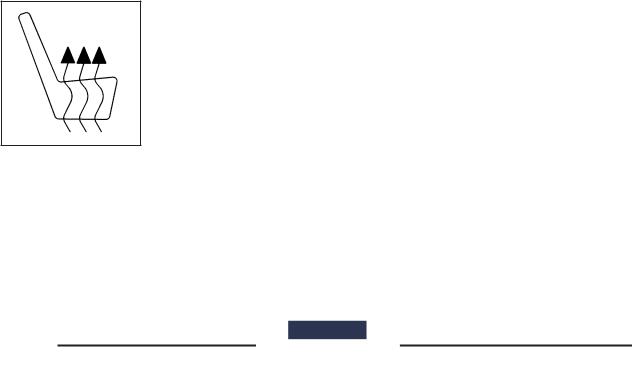
Rear Seats
Heated Seats
On vehicles with rear outboard heated seats, the buttons used to control this feature are located on the Rear Seat Audio (RSA) panel.
Driver Side RSA Heated
Seat Button shown
M (Heated Seat): To heat the seat cushion, press the button with the heated seat symbol.
A heated seat symbol will be shown in the RSA display to indicate that the feature is on. Press the button to cycle through the temperature settings of high, medium, and low, and to turn it off. Indicator bars next to the symbol will designate the level of heat selected: three for high, two for medium, and one for low.
The heated seats are off when the ignition is off.
60/40 Split Bench Seat
(Second Row)
If your vehicle has a 60/40 split bench, the seat(s) can be folded for additional cargo space or folded and tumbled for easy entry and exit to the third row seats, if your vehicle has them. These seats will have either
the manual fold and tumble feature or the automatic seat release fold and tumble feature.
1-14
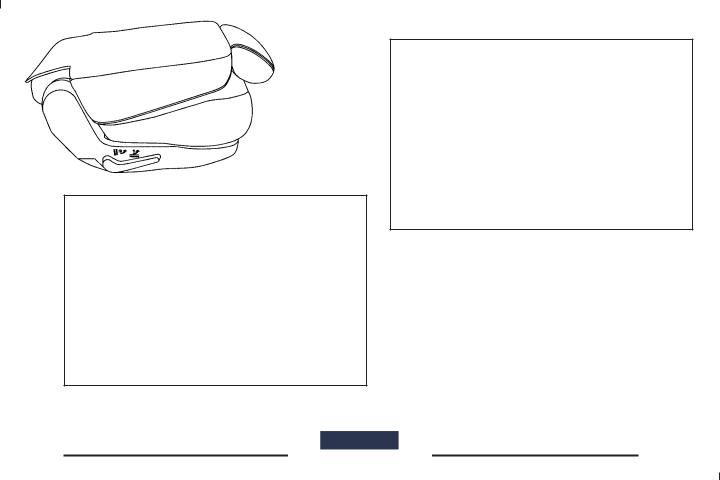
Manual Fold and Tumble Feature
Folding and Tumbling the Seat(s)
To fold and tumble the seat, do the following:
1.Make sure that there is nothing under, in front of, or on the seat.
Notice: Folding a rear seat with the safety belts still fastened may cause damage to the seat or the safety belts. Always unbuckle the safety belts and return them to their normal stowed position before folding a rear seat.
2.Lift the lever, located on the outboard seat, to release the seatback.
The seatback will fold forward automatically. Leaving the seatback in this position creates a flat load floor.
If the seatback cannot fold flat, try moving the front seat forward and/or put the front seatback in the upright position.
1-15
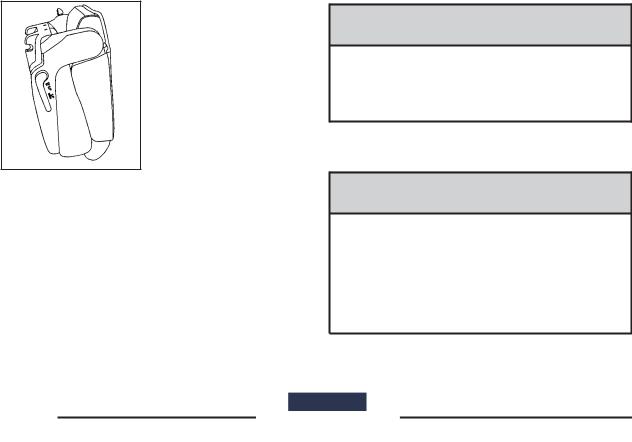
3.Lift the same lever again to release the rear of the seat
from the floor. The seat will tumble forward.
{ CAUTION:
If either seatback is not locked, it could move forward in a sudden stop or crash. That could cause injury to the person sitting there. Always push and pull on the seatbacks to be sure they are locked.
2.Lift the seatback and push it rearward. Push and pull on the seatback to make sure it is locked.
Returning the Seat(s) to the Sitting Position
To return the seat to the sitting position, do the following:
1.Pull the seat down until it latches to the floor. The seatback cannot be raised if the seat is not latched to the floor.
{ CAUTION:
A safety belt that is improperly routed, not properly attached, or twisted will not provide the protection needed in a crash. The person wearing the belt could be seriously injured. After raising the rear seatback, always check to be sure that the safety belts are properly routed and attached, and are not twisted.
3.Make sure the safety belt in the center seating position is not caught between the two seats
twisted.
1-16

Folding and Tumbling the Seat(s) from the Third Row Seats
{ CAUTION:
Using the third row seating position while the second row is folded, or folded and tumbled, could cause injury in a sudden stop or crash. Be sure to return the seat to the passenger seating position. Push and pull on the seat to make sure it is locked into place.
To fold and tumble the seat from the third rows, if your vehicle has them, do the following:
1.Make sure that there is nothing under, in front of, or on the seat.
Notice: Folding a rear seat with the safety belts still fastened may cause damage to the seat or the safety belts. Always unbuckle the safety belts and return them to their normal stowed position before folding a rear seat.
2.Lift the lever(s), located on the bottom rear of the second row seat(s) on the inboard side, to release the seatback. The seatback will fold forward.
3.Lift the same lever again to release the rear of the seat from the floor. The seat will tumble forward automatically.
1-17
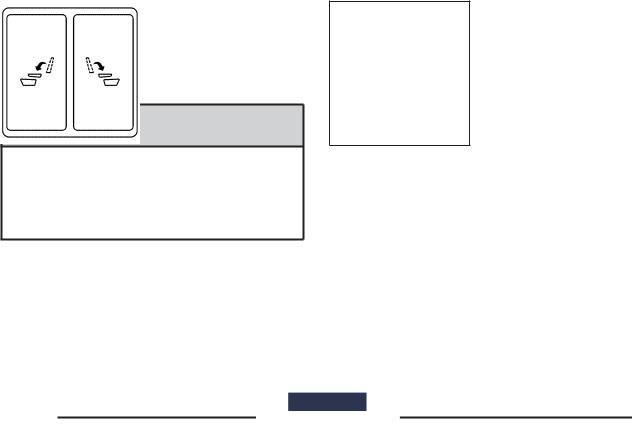
Power Release Fold and Tumble
Feature
The transmission must be in (P) Park for this feature to work.
Folding and Tumbling the Seat(s)
{ CAUTION:
Automatically folding and tumbling the seat when someone is sitting in the seat, could cause injury to the person sitting there. Always make sure there is no one sitting in the seat before pressing the automatic seat release button.
To fold and tumble the seat, do the following:
1.Make sure that there is nothing under, in front of, or on the seat.
Notice: Folding a rear seat with the safety belts still fastened may cause damage to the seat or the safety belts. Always unbuckle the safety belts
and return them to their normal stowed position before folding a rear seat.
2. From the front seats, press one of the automatic seat release buttons located on the overhead console.
Overhead Console
Buttons shown, Panel
Button similar
When accessing the third row seats, if your vehicle has them, from the outside of the vehicle, press the button on the panel behind either rear door.
One press of the button automatically folds the seatback flat and tumbles the seat forward.
There will be a slight delay between the folding of the seatback and the tumbling of the seat.
1-18

Returning the Seat(s) to the Sitting Position
To return the seat to the sitting position, do the following:
1.Pull the seat down until it latches to the floor. The seatback cannot be raised if the seat is not latched to the floor.
{CAUTION:
If either seatback is not locked, it could move forward in a sudden stop or crash. That could cause injury to the person sitting there. Always push and pull on the seatbacks to be sure they are locked.
2.Lift the seatback and push it rearward. Push and pull on the seatback to make sure it is locked.
{ CAUTION:
A safety belt that is improperly routed, not properly attached, or twisted will not provide the protection needed in a crash. The person wearing the belt could be seriously injured. After raising the rear seatback, always check to be sure that the safety belts are properly routed and attached, and are not twisted.
3.Make sure that the safety belt in the center seating position is not caught between the two seats and is not twisted.
1-19

Folding and Tumbling the Second Row Seat(s) from the Third Row Seats or Outside
{ CAUTION:
Using the third row seating position while the second row is folded, or folded and tumbled, could cause injury in a sudden stop or crash. Be sure to return the seat to the passenger seating position. Push and pull on the seat to make sure it is locked into place.
To fold and tumble the seat from the third row seats, if your vehicle has them, do the following:
1.Make sure that there is nothing under, in front of, or on the seat.
Notice: Folding a rear seat with the safety belts still fastened may cause damage to the seat or the safety belts. Always unbuckle the safety belts
and return them to their normal stowed position before folding a rear seat.
2. Press the automatic seat release button located on the panel behind the rear doors.
Driver’s Side Rear Panel
Button shown
One press of the button automatically folds the seatback flat and tumbles the seat forward. There will be a slight delay between the folding of the seatback and the tumbling of the seat.
Bucket Seats (Second Row)
If your vehicle has bucket seats, the seatbacks can be reclined, the seats can be folded for additional cargo space, or folded and tumbled for easy entry and exit to the third row seats, if your vehicle has them. These seats will have either the manual fold and tumble feature or the automatic seat release fold and tumble feature.
1-20
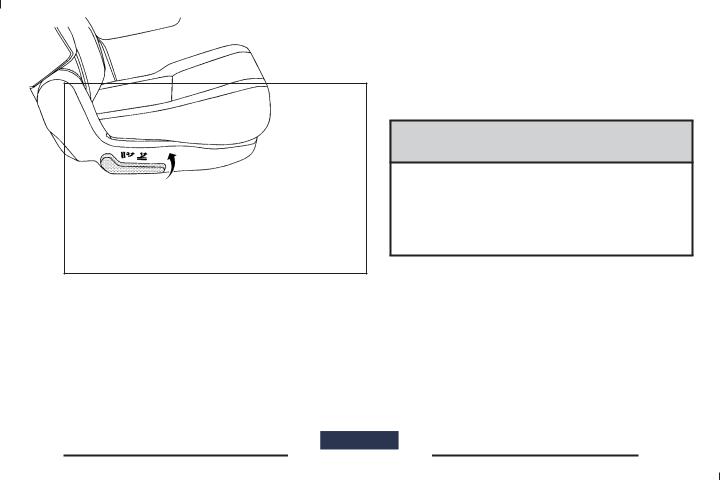
Reclining Seatbacks
To recline the seatback, do the following:
1.Lift the lever located on the outboard side of the seat.
2.Move the seatback to the desired position, then release the lever to lock the seatback in place.
3.Push and pull on the seatback to make sure it is locked.
To return the seatback to an upright position, do the following:
1.Lift the lever fully without applying pressure to the seatback and the seatback will return to the upright position.
{CAUTION:
If either seatback is not locked, it could move forward in a sudden stop or crash. That could cause injury to the person sitting there. Always push and pull on the seatbacks to be sure they are locked.
2.Push and pull on the seatback to make sure it is locked.
1-21

Manual Fold and Tumble Feature
Folding and Tumbling the Seat(s)
To fold and tumble the seat, do the following:
1.Make sure that there is nothing under, in front of, or on the seat.
Notice: Folding a rear seat with the safety belts still fastened may cause damage to the seat or the safety belts. Always unbuckle the safety belts and return them to their normal stowed position before folding a rear seat.
2.Lift the lever, located on the outboard side seat, to release the seatback.
1-22
The seatback will fold forward. Leaving the seatback in this position creates a flat load floor.
If the seatback cannot fold flat, try moving the front seat forward and/or put the front seatback in the upright position.
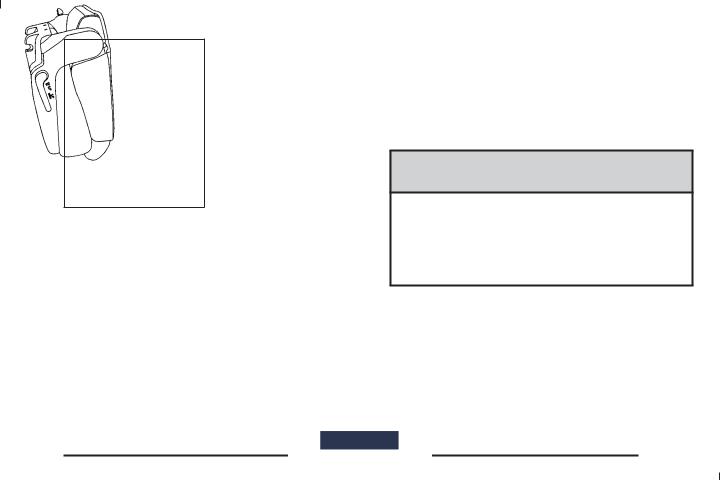
3.Lift the lever again to release the rear of the seat from the floor.
The seat will tumble forward.
Returning the Seat(s) to the Sitting Position
To return the seat to the sitting position, do the following:
1.Pull the seat down until it latches to the floor. The seatback cannot be raised if the seat is not latched to the floor.
{CAUTION:
If either seatback is not locked, it could move forward in a sudden stop or crash. That could cause injury to the person sitting there. Always push and pull on the seatbacks to be sure they are locked.
2.Lift the seatback and push it rearward. Push and pull on the seatback to make sure it is locked.
1-23
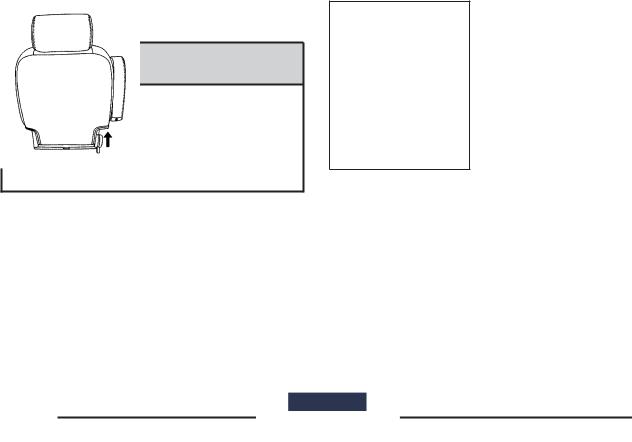
Folding and Tumbling the Seat(s) from the Third Row Seats
{ CAUTION:
Using the third row seating position while the second row is folded, or folded and tumbled, could cause injury in a sudden stop or crash. Be sure to return the seat to the passenger seating position. Push and pull on the seat to make sure it is locked into place.
To fold and tumble the seat from the third row seats, if your vehicle has them:
1.Make sure that there is nothing under, in front of, or on the seat.
Notice: Folding a rear seat with the safety belts still fastened may cause damage to the seat or the safety belts. Always unbuckle the safety belts
and return them to their normal stowed position before folding a rear seat.
2. Lift the lever, located on the bottom rear of the second row seat on the inboard side, to release the seatback. The seatback will
fold forward.
3.Lift the lever again to release the rear of the seat from the floor. The seat will tumble forward.
1-24
